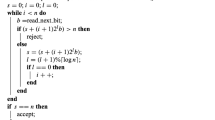Abstract
We consider the pseudo-inversion operation inspired by a biological event as a result of the partial inversion. We define the pseudo-inversion of a string w = uxv to consist of all strings v R xu R, where uv ≠ λ and consider the operation from a formal language theoretic viewpoint. We show that regular languages are closed under the pseudo-inversion operation whereas context-free languages are not. Furthermore, we consider the iterated pseudo-inversion operation and establish the basic properties. Finally, we introduce the pseudo-inversion-freeness and examine closure properties and decidability problems for regular and context-free languages. We establish that pseudo-inversion-freeness is decidable in polynomial time for regular languages and undecidable for context-free languages.
Access this chapter
Tax calculation will be finalised at checkout
Purchases are for personal use only
Preview
Unable to display preview. Download preview PDF.
Similar content being viewed by others
References
Cantone, D., Cristofaro, S., Faro, S.: Efficient string-matching allowing for non-overlapping inversions. Theoretical Computer Science 483, 85–95 (2013)
Chiniforooshan, E., Daley, M., Ibarra, O.H., Kari, L., Seki, S.: One-reversal counter machines and multihead automata: Revisited. Theoretical Computer Science 454, 81–87 (2012)
Cho, D.-J., Han, Y.-S., Kim, H.: Alignment with non-overlapping inversions on two strings. In: Pal, S.P., Sadakane, K. (eds.) WALCOM 2014. LNCS, vol. 8344, pp. 261–272. Springer, Heidelberg (2014)
Daley, M., Ibarra, O.H., Kari, L.: Closure and decidability properties of some language classes with respect to ciliate bio-operations. Theoretical Computer Science 306(1-3), 19–38 (2003)
Daley, M., Kari, L., McQuillan, I.: Families of languages defined by ciliate bio-operations. Theoretical Computer Science 320(1), 51–69 (2004)
Dassow, J., Mitrana, V., Salomaa, A.: Operations and language generating devices suggested by the genome evolution. Theoretical Computer Science 270(1), 701–738 (2002)
Deaton, R., Garzon, M., Murphy, R.C., Rose, J.A., Franceschetti, D.R., Stevens Jr., S.E.: Genetic search of reliable encodings for DNA-based computation. In: First Conference on Genetic Programming, pp. 9–15 (1996)
Garzon, M., Deaton, R., Nino, L.F., Stevens, E., Wittner, M.: Encoding genomes for DNA computing. In: Proceedings of the Third Annual Conference on Genetic Programming 1998, pp. 684–690 (1998)
Ginsburg, S.: Algebraic and automata-theoretic properties of formal languages. North-Holland Publishing Company (1975)
Hopcroft, J., Ullman, J.: Introduction to Automata Theory, Languages, and Computation, 2nd edn. Addison-Wesley, Reading (1979)
Hussini, S., Kari, L., Konstantinidis, S.: Coding properties of DNA languages. Theoretical Computer Science 290(3), 1557–1579 (2003)
Ibarra, O.H.: Reversal bounded multicounter machines and their decision problems. Journal of the ACM 25, 116–133 (1978)
Jonoska, N., Kari, L., Mahalingam, K.: Involution solid and join codes. Fundamenta Informaticae 86(1-2), 127–142 (2008)
Jonoska, N., Mahalingam, K., Chen, J.: Involution codes: With application to DNA coded languages. Natural Computing 4(2), 141–162 (2005)
Jürgensen, H., Konstantinidis, S.: Codes. In: Handbook of Formal Languages. I, pp. 511–607. Springer (1997)
Kari, L., Losseva, E., Konstantinidis, S., Sosík, P., Thierrin, G.: A formal language analysis of DNA hairpin structures. Fundamenta Informaticae 71(4), 453–475 (2006)
Kari, L., Mahalingam, K.: DNA codes and their properties. In: Mao, C., Yokomori, T. (eds.) DNA12. LNCS, vol. 4287, pp. 127–142. Springer, Heidelberg (2006)
Kececioglu, J., Sankoff, D.: Exact and approximation algorithms for the inversion distance between two chromosomes. In: Apostolico, A., Crochemore, M., Galil, Z., Manber, U. (eds.) CPM 1993. LNCS, vol. 684, pp. 87–105. Springer, Heidelberg (1993)
Post, E.L.: A variant of a recursively unsolvable problem. Bulletin of the American Mathematical Society 52(4), 264–268 (1946)
Salomaa, A.: Formal Languages. Academic Press (1973)
Schniger, M., Waterman, M.S.: A local algorithm for DNA sequence alignment with inversions. Bulletin of Mathematical Biology 54(4), 521–536 (1992)
Shallit, J.: A Second Course in Formal Languages and Automata Theory. Cambridge University Press (2009)
Vellozo, A.F., Alves, C.E.R., do Lago, A.P.: Alignment with non-overlapping inversions in O(n 3)-time. In: Bücher, P., Moret, B.M.E. (eds.) WABI 2006. LNCS (LNBI), vol. 4175, pp. 186–196. Springer, Heidelberg (2006)
Wood, D.: Theory of Computation. Harper & Row (1986)
Yokomori, T., Kobayashi, S.: DNA evolutionary linguistics and RNA structure modeling: A computational approach. In: Proceedings of the 1st Intelligence in Neural and Biological Systems, pp. 38–45. IEEE Computer Society (1995)
Author information
Authors and Affiliations
Corresponding author
Editor information
Editors and Affiliations
Rights and permissions
Copyright information
© 2014 Springer International Publishing Switzerland
About this paper
Cite this paper
Cho, DJ., Han, YS., Kang, SD., Kim, H., Ko, SK., Salomaa, K. (2014). Pseudo-inversion on Formal Languages. In: Ibarra, O., Kari, L., Kopecki, S. (eds) Unconventional Computation and Natural Computation. UCNC 2014. Lecture Notes in Computer Science(), vol 8553. Springer, Cham. https://doi.org/10.1007/978-3-319-08123-6_8
Download citation
DOI: https://doi.org/10.1007/978-3-319-08123-6_8
Publisher Name: Springer, Cham
Print ISBN: 978-3-319-08122-9
Online ISBN: 978-3-319-08123-6
eBook Packages: Computer ScienceComputer Science (R0)




